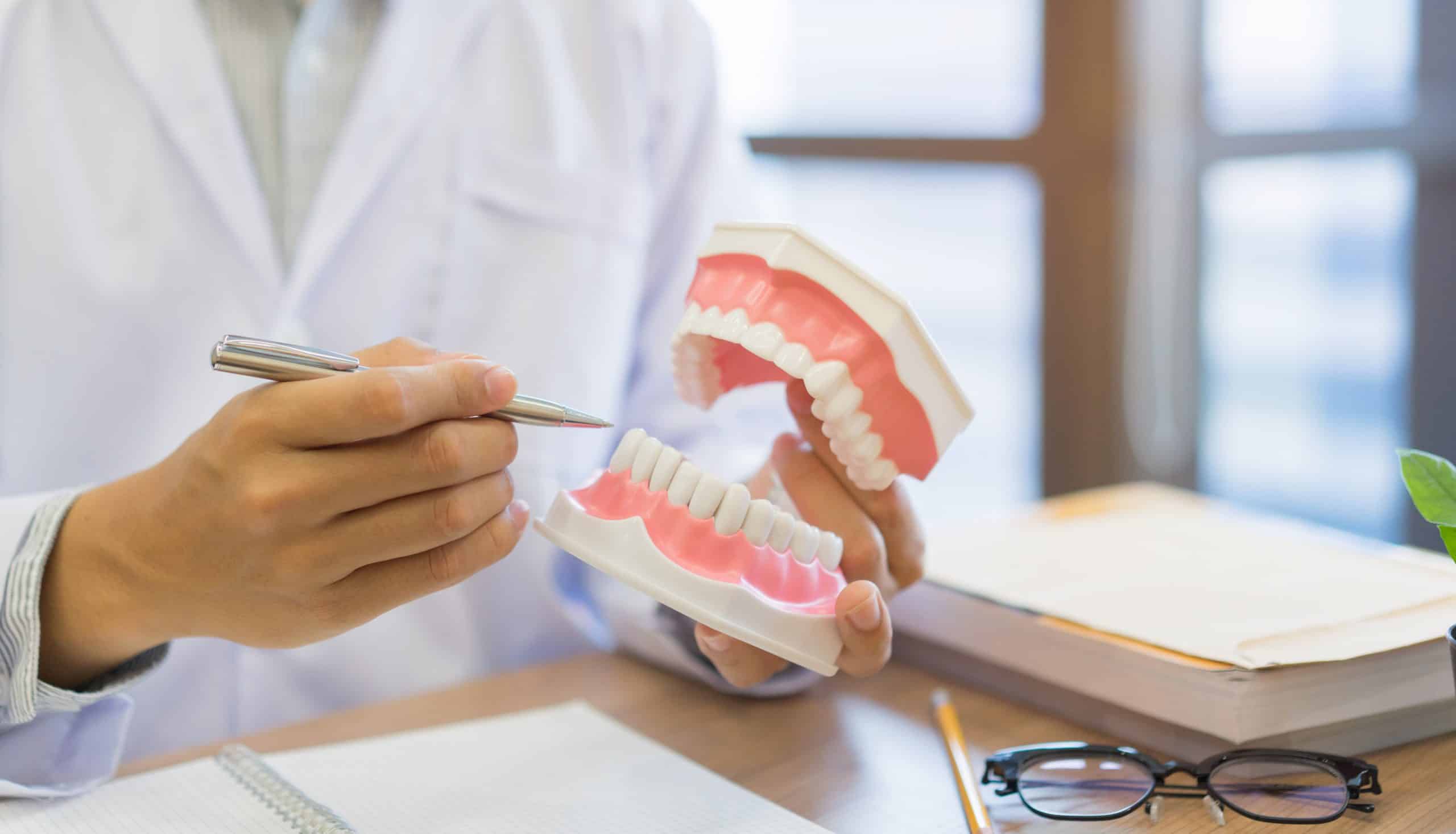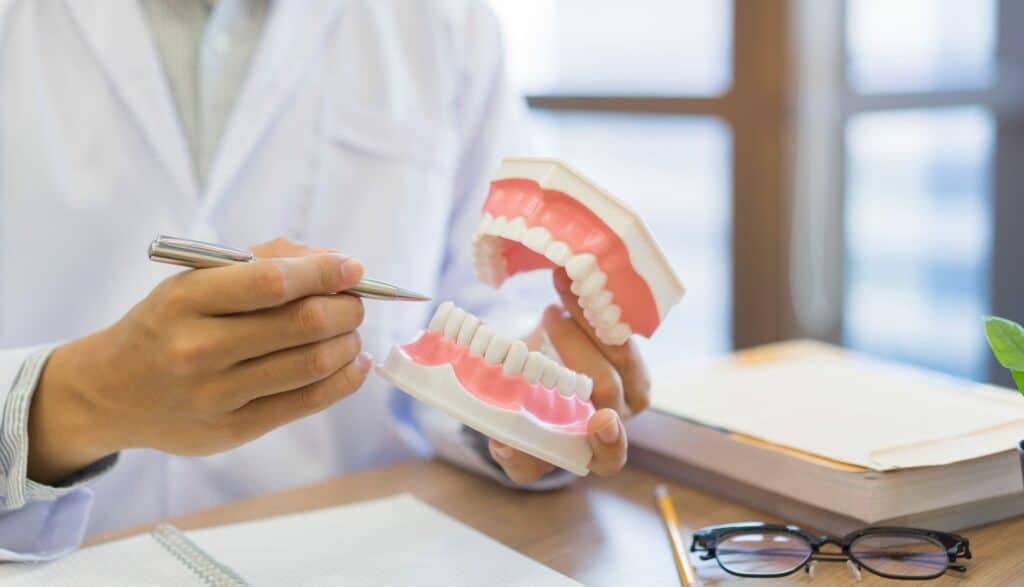Periodontal Disease: Symptoms, Causes, & Treatment

Periodontal disease (also known as periodontitis or gum disease) is a serious infection that affects the gums. It’s caused by the buildup of bacteria that sits on the teeth and gums, slowly eating away at the soft tissue before eventually reaching your teeth and even your bones. If periodontal disease is left untreated, it can eventually cause your teeth to fall out. Even worse, it can lead to many other serious health risks such as heart attack and or stroke.
The Stages of Periodontal Disease
Periodontal disease gets progressively worse over time and is usually categorized into different stages.
Gingivitis (inflammation)
Periodontal disease starts as inflammation, also known as gingivitis. The most common sign of this stage is bleeding when you brush or floss your teeth. If you brush too hard or vigorously, it can also cause your gums to bleed. It’s important to understand the difference so you don’t improperly diagnose yourself. When in doubt, speaking to dental experts and booking an appointment can help you identify oral health issues before they have a chance to do damage.
Another common sign of gingivitis is discoloration on your teeth. This is known as dental plaque, a sticky buildup of bacteria and food on your teeth. If not removed through brushing, this sticky substance hardens and is difficult to remove. This often occurs when you don’t brush your teeth regularly or forget to floss on a regular basis. Bacteria is always present on our teeth, but if we let it build up by neglecting to brush, it can turn into plaque which is hard to get rid of.
Receding Gums
One of the first signs of periodontal disease is a receding gum line. Your gums will pull away from your teeth, exposing more of your tooth and also creating gaps between them. These gaps can trap debris and food, making it difficult to clean without regular brushing and flossing. During this stage, you may also experience a bit of bleeding when you brush your gums.
Your gums recede as a means of fighting against the infection. As such, it’s important to start taking action now before your gums continue receding and expose more of your teeth.
Heavy Bleeding and Pain
If your periodontal disease continues to progress, it can lead to more severe bleeding around your teeth. Gums will continue to recede, leaving large gaps between certain teeth where the infection is most active. You might also begin to lose bone support, resulting in teeth that feel loose.
In some cases, the inflammatory response may affect your entire body, causing aches or pains in your teeth and gums.
Further Pain and Severe Bad Breath
In its advanced stages, periodontal disease will cause the connective tissue between your teeth and gums to deteriorate. This makes your teeth extremely loose and could cause pain whenever you chew. You’ll also experience bad breath and potentially a strange or foul taste in your mouth. At this stage, you’re very likely to lose your teeth if you’re not careful about maintaining good dental hygiene. You’ll want to contact a professional dental service such as Rinaldi Dental Arts to help you with periodontal disease. This will ensure that you don’t lose your teeth and can start recovering from the pain and discomfort you experience.
Common Symptoms of Periodontal Disease
Let’s take a look at the most common symptoms of periodontal disease. Keep in mind that these symptoms will vary depending on the stage.
- Bleeding gums when brushing or flossing
- Teeth that feel loose
- Changes in the position of your teeth
- Receding gums
- Bad breath
- Foul taste in your mouth
- Red or tender gums
- Tartar or plaque buildup on your teeth
- Pain when chewing
- Loss of teeth
Most early symptoms of periodontitis are difficult to detect since they are often related to other conditions. For example, forceful brushing can lead to bleeding gums, so you might not think much about it. However, it’s important to have regular checkups with a dentist to detect issues as soon as possible. Dr. Rinaldi at Rinaldi Dental Arts can help you with that.
Causes of Periodontal Disease
Periodontal disease is typically caused by excess buildup of bacteria in your mouth. While mostly harmless in small numbers, bacteria can grow in number and severity if dental hygiene is not maintained. If you don’t brush your teeth and gums, especially in hard-to-reach areas, the bacteria will multiply and develop into plaque. This plaque, if left to grow, can eventually develop into tartar which encourages even more bacterial growth near the root of the tooth.
If ignored, your body’s response to bacterial growth can cause inflammation in the gums. This can lead to bleeding and toxins that damage the gums further while also affecting the supporting bone structures. There are also other risk factors that can put you at a higher risk of developing periodontal disease. This includes:
- Obesity
- Smoking
- Diabetes
- Hormonal changes in women
- Immunodeficiencies
- Genetic conditions
- Medications that affect the saliva in your mouth
- Poor nutrition
Periodontal Disease Treatments
Treatments typically follow a three-step process.
1. Professional Cleaning Treatment
First, your dentist cleans your teeth to remove any plaque and tartar buildup on the teeth and roots. This can take a long time if you’ve not had a professional cleaning in a while. A deep cleaning may also be required if there are small pockets with a lot of bacteria buildup.
Antibiotics may be prescribed if you are susceptible to gum infections. This is usually in the form of a mouthwash, gel, or oral tablet.
2. Good Oral Hygiene Practices
Next, your dentist will teach you about oral hygiene practices to help you keep your teeth and mouth clean. This generally involves teaching you how to brush properly, how to floss to remove plaque and bacteria buildup, and recommending you to visit the dental office at least twice a year.
3. Surgery As The Last Resort
If inflammation is persistent and a cleaning doesn’t help, then your dentist may suggest cleaning the deposits underneath your gums. This is called pocket reduction surgery. This involves using local anesthetic or anesthesia to put you to sleep. With pocket reduction surgery, a tiny incision is made in your gums and the gum is lifted away from the roots to allow thorough cleaning. Your gums are stitched back into place. This surgical procedure is only a last resort and carried out by experts.
LANAP: An Alternative to Surgery
An alternative to pocket reduction surgery is a procedure called Laser-Assisted New Attachment Procedure or LANAP. LANAP does not require scalpel and sutures, it does not require anesthetic, is less invasive, and recovery time is about 24 hours. In fact, after the procedure, you can go about your day as normal with minimal pain.
If you’d like to learn more about periodontal disease or are looking for solutions, don’t hesitate to get in touch with us today to book an appointment with one of our dentists.
